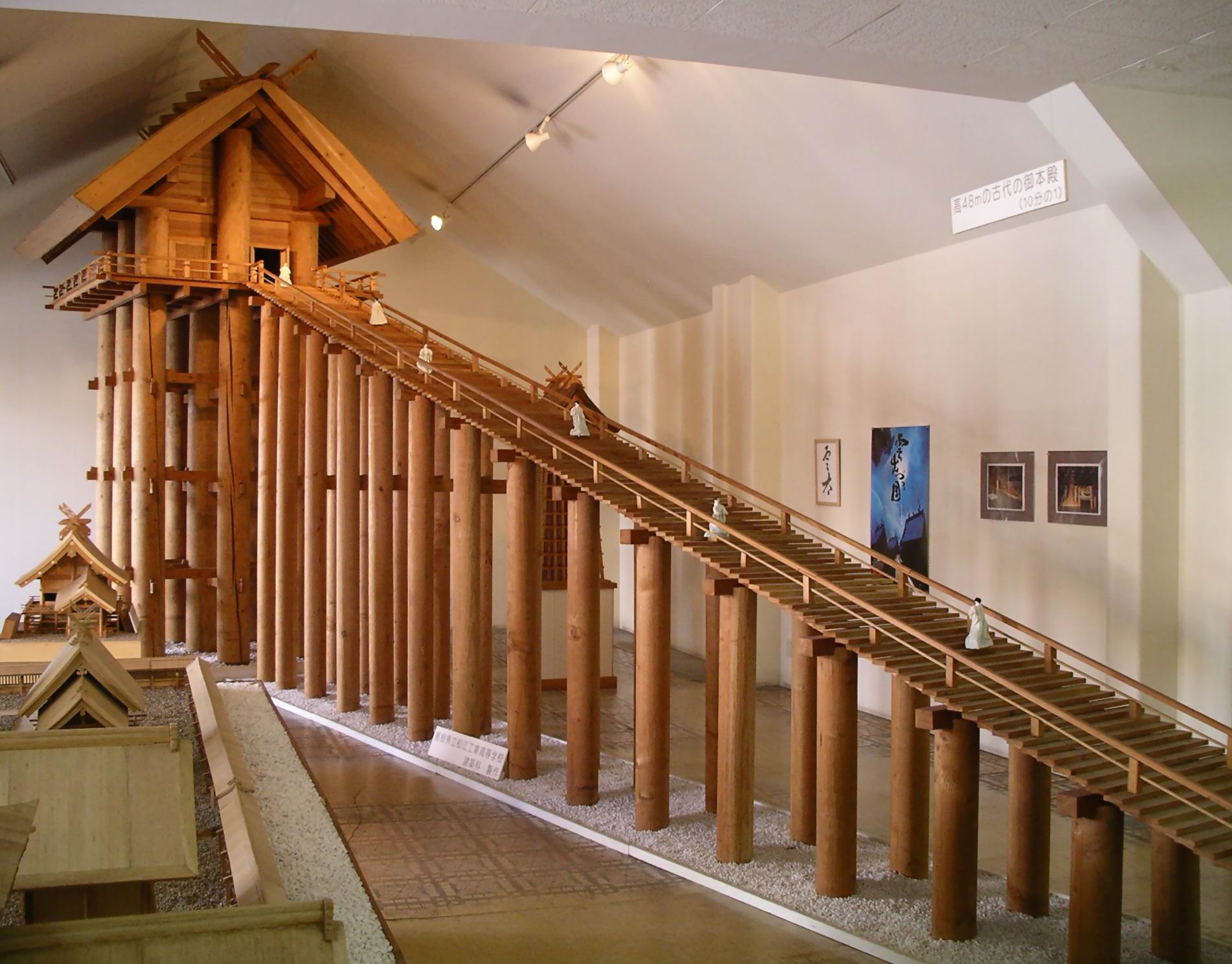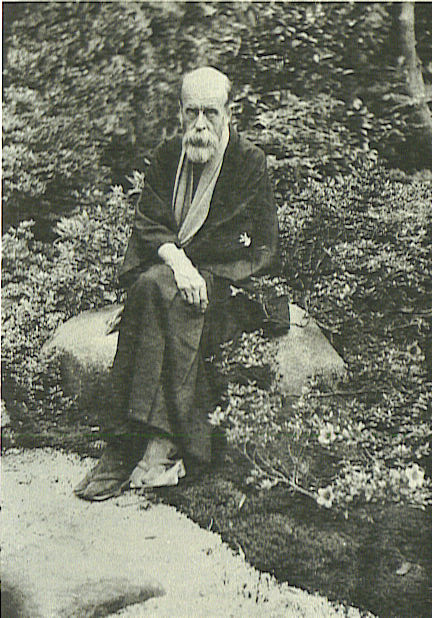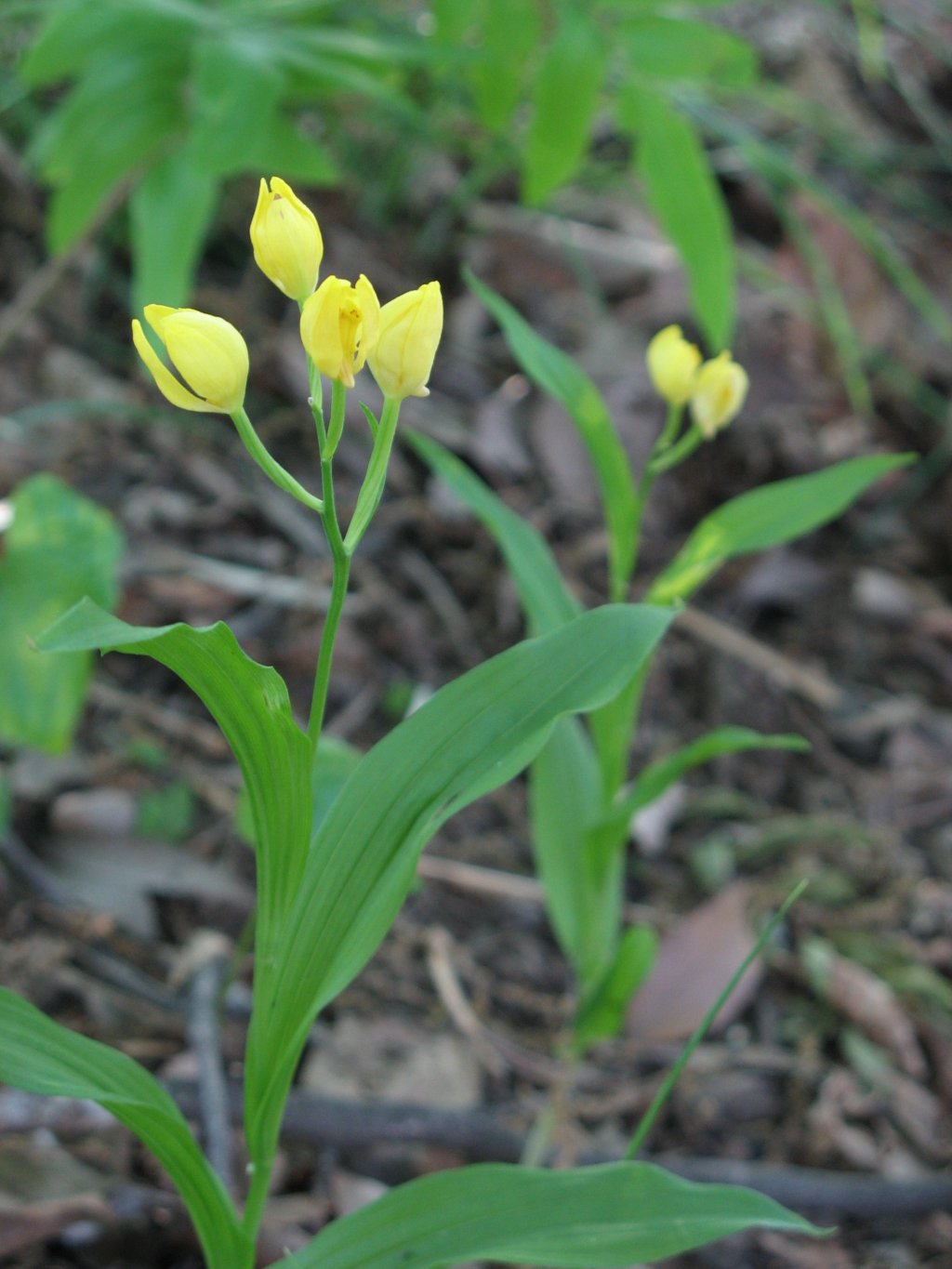|
Izumo Clan
The Izumo clan is a Japanese noble family descended from Ame no Hohi who used to rule Izumo Province and run Izumo Taisha today. The clan were originally Kuni no miyatsuko but after the abolition of the role they took on a priestly role at Izumo-taisha, they share this history with the Aso clan of Aso Shrine, the Owari clan of Atsuta Shrine, the of Munakata Taisha, and the Yamato clan of Ōyamato Shrine. From the beginning the role of Izumo no Kuni no Miyatsuko was seen as substantially more important than the other Kuni no miyatsuko. They held the position of Kuni no miyatsuko of Izumo Province. They now run Izumo-taishakyo as the Senge family. The head of the family was still called the Kokuzo or Kuni no MIyatsuko in the medieval period, long after the Kuni no Miyatsuko of other provinces ceased to be relevant. Their position as a religious authority is sometimes seen as in contrast to the Yamato as an "other Japan". Their religious authority was somewhat unusual among ... [...More Info...] [...Related Items...] OR: [Wikipedia] [Google] [Baidu] |
Izumo Province
was an Old provinces of Japan, old province of Japan which today consists of the eastern part of Shimane Prefecture. It was sometimes called . The province is in the Chūgoku region. History During the early Kofun period (3rd century) this region was independent and constructed rectangular tumuli. But in the fourth century this region saw the construction of rectangular and key shaped tumuli. During the 6th or 7th century it was absorbed due to the expansion of the state of Yamato Province, Yamato, within which it assumed the role of a sacerdotal domain. Today, the Izumo Shrine constitutes (as does the Grand Shrine of Ise) one of the most important sacred places of Shinto: it is dedicated to ''kami'', especially to Ōkuninushi (''Ō-kuni-nushi-no-mikoto''), mythical progeny of Susanoo and all the clans of Izumo. The mythological mother of Japan, the goddess Izanami, is said to be buried on Mt. Hiba, at the border of the old provinces of Izumo and Hōki Province, Hōki, near mo ... [...More Info...] [...Related Items...] OR: [Wikipedia] [Google] [Baidu] |
Imperial House Of Japan
The is the reigning dynasty of Japan, consisting of those members of the extended family of the reigning emperor of Japan who undertake official and public duties. Under the present constitution of Japan, the emperor is "the symbol of the State and of the unity of the people". Other members of the imperial family perform ceremonial and social duties, but have no role in the affairs of government. The duties as an emperor are passed down the line to their male children. The Japanese monarchy is the oldest continuous hereditary monarchy in the world. The imperial dynasty does not have a name, therefore its direct members do not have a family name. Origins and name The imperial house recognizes 126 monarchs, beginning with Emperor Jimmu (traditionally dated to 11 February 660 BCE), and continuing up to the current emperor, Naruhito. However, scholars have agreed that there is no evidence of Jimmu's existence, that the traditional narrative of the imperial family's founding is ... [...More Info...] [...Related Items...] OR: [Wikipedia] [Google] [Baidu] |
Izumo Grand Shrine
, officially Izumo Ōyashiro, is one of the most ancient and important Shinto shrines in Japan. No record gives the date of establishment. Located in Izumo, Shimane Prefecture, it is home to two major festivals. It is dedicated to the god , famous as the Shinto deity of marriage and to Kotoamatsukami, distinguishing heavenly ''kami''. The shrine is believed by many to be the oldest Shinto shrine in Japan, even predating the Ise Grand Shrine. A style of architecture, ''taisha-zukuri'', takes its name from the main hall of Izumo-taisha. That hall, and the attached buildings, were designated National Treasures of Japan in 1952. According to tradition, the hall was previously much taller than at present. The discovery in the year 2000 of the remains of enormous pillars has lent credence to this. The shrine has been rebuilt every 60 to 70 years to maintain the power of the ''kami'' and maintain architectural techniques. This regular rebuilding process is called " Sengū" (遷宮) a ... [...More Info...] [...Related Items...] OR: [Wikipedia] [Google] [Baidu] |
Kuni No Miyatsuko Families
Kuni or KUNI may refer to: People * Kuni-no-miya (久邇) ''ōke'' (princely house), the second oldest branch of the Japanese Imperial Family created from branches of the Fushimi-no-miya house * Kuni Nagako (1903–2000), member of the Imperial House of Japan * Kuni, an alias of the music artist, DJ, and music producer Kuniyuki Takahashi * Kuni, a character played by Gedde Watanabe in ''UHF'', who also appeared in an episode of ''The Weird Al Show'' Geography * Kuni (woreda), Ethiopia * Kuni, Gunma, a former village in Gunma, Japan * Kuni-kyō, an 8th-century capital of Japan * Provinces of Japan were first-level administrative divisions of Japan from the 600s to 1868. Provinces were established in Japan in the late 7th century under the Ritsuryō law system that formed the first central government. Each province was divided into and ... * Kuni, Eastern Cape, a township in Buffalo City, South Africa Other uses * Kuni language, spoken by 2400 people in Papua New Gui ... [...More Info...] [...Related Items...] OR: [Wikipedia] [Google] [Baidu] |
Richard Ponsonby-Fane
Richard Arthur Brabazon Ponsonby-Fane (8 January 1878 – 10 December 1937) was a British academic, author, specialist of Shinto and Japanologist. Early years Richard Arthur Brabazon Ponsonby was born at Gravesend, Kent, Gravesend on the south bank of the Thames in Kent, England to John Ponsonby-Fane, John Henry and Florence Ponsonby. His boyhood was spent in the family home in London and at the Somerset country home, Brympton d'Evercy, of his grandfather, Spencer Ponsonby-Fane."A Biographical sketch of Dr. R. Ponsonby-Fane," ''Studies in Shinto and Shrines,'' p. 517. Ponsonby was educated at Harrow School. He added "Fane" to his own name when he inherited Brympton d'Evercy in 1916 after the deaths of both his grandfather and father. Career In 1896, Ponsonby traveled to Cape Town to serve as Private Secretary to the British Cape Colony, Governor of the British Cape Colony.Ponsonby-Fane, p. 518. For the next two decades, his career in the British Empire's colonial governments ... [...More Info...] [...Related Items...] OR: [Wikipedia] [Google] [Baidu] |
Akihito
Akihito (born 23 December 1933) is a member of the Imperial House of Japan who reigned as the 125th emperor of Japan from 1989 until 2019 Japanese imperial transition, his abdication in 2019. The era of his rule was named the Heisei era, Heisei being an expression of achieving peace worldwide. Born in 1933, Akihito is the fifth child and first son of Hirohito, Emperor Shōwa and Empress Nagako, Empress Kōjun. During the Second World War, he moved out of Tokyo with his classmates and remained in Nikkō until 1945. In 1952, his Coming-of-Age ceremony and investiture as crown prince were held, and he began to undertake official duties in his capacity as crown prince. The next year, he made his first journey overseas and represented Japan at the coronation of Elizabeth II in London. He completed his university education in 1956. In April 1959, he married Empress Michiko, Michiko Shōda, a commoner; it was the first imperial wedding to be televised in Japan, drawing about 15 mill ... [...More Info...] [...Related Items...] OR: [Wikipedia] [Google] [Baidu] |
Princess Noriko
, formerly , is a former member of the Imperial House of Japan and the second daughter of Norihito, Prince Takamado and Hisako, Princess Takamado. She married Kunimaro Senge, a commoner, on 5 October 2014. As a result, she gave up her imperial title and left the Japanese Imperial Family, as required by law. Biography Princess Noriko was born on 22 July 1988 at Aiiku Hospital in Minami-Azabu, Tokyo. After her birth, her father, Prince Takamado, chose her name. She went to Gakushuin Kindergarten. After that she attended the prestigious Gakushuin School for her primary, junior high, and high school education. In April 2007, Princess Noriko enrolled in the Gakushuin University, Faculty of Letters, Department of Psychology, and expressed her intent to pursue studies in the field of clinical psychology. In July 2008, she came of age and attended official ceremonies in Japan with the other members of the Imperial Family. She attended official functions at the palace and accomp ... [...More Info...] [...Related Items...] OR: [Wikipedia] [Google] [Baidu] |
Occupation Of Japan
Japan was occupied and administered by the Allies of World War II from the surrender of the Empire of Japan on September 2, 1945, at the war's end until the Treaty of San Francisco took effect on April 28, 1952. The occupation, led by the American military with support from the British Commonwealth and under the supervision of the Far Eastern Commission, involved a total of nearly one million Allied soldiers. The occupation was overseen by the US General Douglas MacArthur, who was appointed Supreme Commander for the Allied Powers by the US president Harry S. Truman; MacArthur was succeeded as supreme commander by General Matthew Ridgway in 1951. Unlike in the occupations of Germany and Austria, the Soviet Union had little to no influence in Japan, declining to participate because it did not want to place Soviet troops under MacArthur's direct command. This foreign presence marks the only time in the history of Japan that it has been occupied by a foreign power. Howe ... [...More Info...] [...Related Items...] OR: [Wikipedia] [Google] [Baidu] |
Government Of Meiji Japan
The was the government that was formed by politicians of the Satsuma Domain and Chōshū Domain in the 1860s. The Meiji government was the early government of the Empire of Japan The Empire of Japan, also known as the Japanese Empire or Imperial Japan, was the Japanese nation state that existed from the Meiji Restoration on January 3, 1868, until the Constitution of Japan took effect on May 3, 1947. From Japan–Kor .... Politicians of the Meiji government were known as the Meiji oligarchy, who overthrew the Tokugawa shogunate. Early developments After the Meiji Restoration, the leaders of the ''samurai'' who overthrew the Tokugawa shogunate had no clear agenda or pre-developed plan on how to run Japan. They did have a number of things in common; according to Andrew Gordon, “It was precisely their intermediate status and their insecure salaried position, coupled with their sense of frustrated ambition and entitlement to rule, that account for the revolutionary ene ... [...More Info...] [...Related Items...] OR: [Wikipedia] [Google] [Baidu] |
Senge Takatomi
Baron Takatomi Senge was a Japanese priest and politician. He served as governor of their prefectures. He was Governor of Saitama from 1894-1897, Governor of Shizuoka from 1897-1898, and Governor of Tokyo from 1898-1908. He was also a member of the House of Peers. He was an organizer of the 1907 Tokyo Industrial Exhibition. He was a Shinto Priest and the founder of Izumo-taishakyo, and the 80th high priest of Izumo-taisha (an eightieth generation descendant of the first Izumo no Kuni no Miyatsuko). He founded the (, The Thursday Association) a Japanese political faction dedicated to representing the interests of barons over higher nobility. Ancestry The descendants of , the second son of , the sun goddess whose first son is the ancestor of the imperial family, have been, in the name of or governor of Izumo, taking over rituals because when Izumo-taisha was founded Amenohohi-no-mikoto rendered service to Okuninushi-no-kami. The family's conflict around 1340 made them s ... [...More Info...] [...Related Items...] OR: [Wikipedia] [Google] [Baidu] |
Amaterasu
, often called Amaterasu () for short, also known as and , is the goddess of the sun in Japanese mythology. Often considered the chief deity (''kami'') of the Shinto pantheon, she is also portrayed in Japan's earliest literary texts, the () and the (720 CE), as the ruler (or one of the rulers) of the heavenly realm Takamagahara and as the mythical ancestress of the Imperial House of Japan via her grandson Ninigi. Along with two of her siblings (the moon deity Tsukuyomi and the impetuous storm-god Susanoo) she ranks as one of the "Three Precious Children" (, ), the three most important offspring of the creator god Izanagi. Amaterasu's chief place of worship, the Grand Shrine of Ise in Ise, Mie Prefecture, is one of Shinto's holiest sites and a major pilgrimage center and tourist spot. As with other Shinto ''kami'', she is also enshrined in a number of Shinto shrines throughout Japan. Name The goddess is referred to as ''Amaterasu Ōmikami'' ( / ; historical orthogr ... [...More Info...] [...Related Items...] OR: [Wikipedia] [Google] [Baidu] |
Amenohohi-no-mikoto
Ame no Hohi (天菩比神, 天穗日命,アメノホヒ, "Heavenly grain sun"), also known as Ame no Fuhi (天乃夫比, アメノフヒ) is a male deity and the second son of sun goddess Amaterasu in Japanese mythology. Izumo no Kuni no Miyatsuko or the historical rulers of Izumo and modern heads of Izumo-taisha and Izumo-taishakyo descend from him. Mythology Ame no Hohi is found in the main works of literature that record the mythology and the mythologized history of Japan. He is found in both the and the as Ame no Hohi no Mikoto (: 天之菩卑能命, 天菩比命, 天菩比神; : 天穂日命). In the he is referred to as Ame no Fuhi no Mikoto (天乃夫比命). He is also mentioned in the by the name Ame no Hohi no Mikoto (天穂比命). In some myths he was sent first to earth to rule after his brother Ame-no-oshihomimi refused the offer. However, when he didn't return after three years they sent another god to rule. Family Ame no Hohi's sons are called Ame-no ... [...More Info...] [...Related Items...] OR: [Wikipedia] [Google] [Baidu] |





